The LG G2 is the company's first smartphone to be
powered by Android 4.2.2 Jelly Bean. Naturally LG's own Optimus UI topping is
overhauls the entire OS. The customizations run deep and there's a rich
selection of themes, changeable icons and home-brewed apps.

Key features
Ø
Quad-band GSM/GPRS/EDGE support
Ø
Quad-band 3G with HSPA; Penta-band LTE cat3
Ø
5.2" 16M-color 1080p True HD IPS Plus
FullHD capacitive touchscreen
Ø
Corning Gorilla Glass 3 display protection
Ø
Android OS v4.2.2 Jelly Bean; LG Optimus UI
Ø Quad-core
2.26 GHz Krait 400 CPU, 2 GB RAM, Adreno 330 GPU, Qualcomm Snapdragon 800
chipset
Ø
13 MP autofocus camera with LED flash,
geotagging, Intelligent Auto, optical image stabilization,Time catch shot,
smart shutter and VR panoramas
Ø
1080p video recording @ 60fps with continuous
autofocus and stereo sound; HDR mode, Dual recording, optical image
stabilization
Ø
2.1 MP front-facing camera, 1080p video recording
Ø
32GB of built-in storage, 24GB user-available
Ø
microUSB port, USB host support, USB on-the-go,
SlimPort TV-out
Ø
Bluetooth v4.0
Ø
NFC
Ø
Wi-Fi a/b/g/n/ac, Wi-Fi Direct and DLNA
Ø
GPS with A-GPS, GLONASS
Ø
Standard 3.5 mm audio jack
Ø
Stereo FM radio with RDS
Ø
Voice commands
Ø
Multi-tasking with mini-apps and optional
transparency (QSlide)
Ø
Accelerometer and proximity sensor
Ø
Active noise cancellation with dedicated mic
Ø
Non-replaceable 3000mAh Li-Po battery
Ø
IR emitter for remote control of home appliances
Ø
Quick Window cases available at launch
We took
a quick look at the G2 at the announcement event, now we have our hands on
a G2 and have been putting it through its paces, benchmarking it, and
running battery life tests on it for a little under a week and wanted to share
some thoughts.
Hardware Impressions

The G2 marries a curved backside shape with front glass that slightly curves at the edges and has a very narrow side bezel. The G2 also opts for on-screen buttons rather than the discrete capacitive kind or physical buttons that went out of favor a while ago. The reality is that Google does have a fair amount of input into at least this part of the Android ecosystem, and its guidance seems to be that on-screen buttons which use display real estate to draw the buttons is the recommended way to go. The G2 does afford the ability however to add Quick Memo buttons or the notification shade pull down/pull up buttons to the bar, but oddly enough there's no multitasking button option available.
The G2 manages to include a large display without
width that's much different from other devices I've been using lately, like the
HTC One. Part of getting the edge bezel small was a reduction in volume required
on the sides for volume and power buttons, which are instead moved to the back
of the G2, perhaps its most striking and initially even alarming design change.

Holding down the volume down button launches you into the camera, pressing the center button powers on the phone, and holding down the top button launches QuickMemo. Up and down are volume up and down otherwise. There's a hard raised lip on both sides of the button too, so the G2 when laid backside down on a surface makes contact there instead of on the button – it won't inadverntely turn on when pressed against a table. I found the backside buttons easy to adapt to after my first few interactions with the G2, and they actually become second nature after a day or so. The raised bump for the power button makes it easy to locate with the index finger, and I haven't smeared or accidentally put my finger on the sapphire camera cover yet. If the power button on the back is still difficult to get used to, the G2 has a double tap to turn on feature it calls "knock knock" – double tap on the display, and the G2 will turn on, repeat the double tap on the status bar or in an empty part of the display when it's on, and it turns off. I find myself using the double tap gesture quite a bit to turn the G2 on and off. I believe this functionality uses the sensors onboard and the DSP inside 8974 to detect when the taps occur.
The G2 I was sampled is a dark
blue color which has a slight pinstripe on the back as shown in the photos
above. The material is however the same kind of glossy plastic I'm used to
seeing out of the Korean handset makers of note, and picks up fingerprints and
hand oil very quickly unfortunately. I like the shape of the device and LG's
innovations, it's just puzzling to me that materials hasn't picked up yet, I'd
even take glass from the Optimus G over plastic. I'll save you the huge
discussion on device size as well, I'm fine with the larger smartphones that
aren't quite phablets, and the G2 for me is totally usable and I appreciate the
increased display size. It definitely isn't phablet size, but it is on the
larger high-end smartphone side of things.
Display
We've been very pleased with what comes out of LG Display as of late,
and the G2 doesn't disappoint. It's a 5.2-inch diagonal LCD with
1920x1080 resolution for 423 PPI density. Of course, it isn't just
resolution that matters, but of course calibration, viewing angles, and other
quality measures. What's interesting
about the G2 is that it
has two discrete touchscreen matrices
which get routed to the top and bottom and out two different connectors. LG
says this allows it to get the bezels on the G2 down to 2.65mm. I find a lot of
what constrains device size lately is really width rather than height, and
maximizing the amount of the front area used by display helps devices include
bigger displays without getting too largeLG G2 display under a microscope






Battery Life
One of the things Qualcomm promised would come with Snapdragon 800 (8974) (and by extension the process improvement with 28nm HPM) was lower power consumption, especially versus Snapdragon 600 (8064). There are improvements throughout the overall Snapdragon 800 platform which help as well, newer PMIC (PM8941) and that newer modem block onboard as well, but overall platform power goes down in the lower performance states for Snapdragon 800. In addition the G2 has a few unique power saving features of its own, including display GRAM (Graphics RAM) which enables the equivalent of panel self refresh for the display. When the display is static, the G2 can run parts of the display subsystem and AP off and save power, which they purport increases the mixed use battery life case by 10 percent overall, and 26 percent compared to the actively refreshing display equivalent. In addition the G2 has a fairly sizable 3000 mAh 3.8V (11.4 watt-hour) battery which is stacked to get the most out of the rounded shape of the device, and utilizes LG's new SiO+ anode for increased energy density compared to the conventional graphite anode.




The LG G2 battery life is shockingly good through our tests, and in
subjective use. The combination of larger battery, GRAM for panel self refresh,
new HK-MG process, and changes to the architecture dramatically improve things
for the G2 over the Optimus G. While running the two web browsing tests I
suspected that the G2 might be my first phone call test to break 24 hours,
while it doesn't break it it comes tantalizingly close at 23.5 hours. I'm very
impressed with the G2 battery life.

CPU Performance
LG's G2 features a quad-core Snapdragon 800 SoC (MSM8974). For a quick refresher, Snapdragon 800 features four Krait 400 cores running at up to 2.3GHz courtesy of TSMC's 28nm HPM process. The 2.3GHz max clock speed comes at a surprisingly low voltage thanks to the low power HPM process. Gone are the days of 1.4V to hit near-2GHz frequencies it seems, instead 8974 will hit 2.3 GHz at around 1V. Krait 400 improves L2 access latencies over Krait 300 (which is at the heart of Snapdragon 600 and S4 Pro) and is optimized for higher frequency operation, but Krait 400 is otherwise architecturally similar to Krait 300. Make no mistake, MSM8974 is the new high-end, pushing Snapdragon 600 and S4 Pro parts further down into midrange category. There are other SoC level enhancements as well, including things like a new version of the Hexagon DSP and obviously Adreno 330 vs. Adreno 320 (which I'll get to later). We already ran through a performance preview of Snapdragon 800/MSM8974 using Qualcomm's 8974 Tablet Mobile Development Platform, but today we get to do the same with the G2.






GPU Performance
Snapdragon 800 features Qualcomm's
Adreno 330 GPU. Qualcomm hasn't stated publicly how Adreno 330 compares to
Adreno 320 featured in Snapdragon 600, but it's almost certainly a larger GPU.
The 8974 implementation in LG's G2 clocks the Adreno 330 GPU at a maximum of
450MHz, yet we see better performance than the 450MHz Adreno 320 in Snapdragon
600 - lending credibility to the idea of having more execution resources.
There's also an 8974AB variant which includes a 100 MHz bump in GPU clocks up
to 550 MHz.
3DMark
3DMark for Android features the Ice
Storm benchmark and uses OpenGL ES 2.0. Ice Storm is divided into two graphics
tests and a physics test. The first graphics test is geometry heavy while the
second test is more pixel shader intensive. The physics test, as you might
guess, is CPU bound and multithreaded. The overall score takes into account
both graphics and physics tests. The benchmark is rendered to an offscreen
buffer at 720p/1080p and then scaled up to the native resolution of the device
being tested. This is a very similar approach we've seen by game developers to
avoid rendering at native resolution on some of the ultra high resolution
tablets. The beauty of 3DMark's approach here is the fact that all results are
comparable, regardless of a device's native resolution. The downside is we
don't get a good idea of how some of the ultra high resolution tablets would
behave with these workloads running at their native (> 1080p) resolutions.
For these benchmarks we stuck with the
default presets (720p, normal quality).
3DMark performance generally fell very
close to Qualcomm's MSM8974 MDP/T, with one exception. The CPU bound physics
tests had the G2 far lower down the list than I would've expected. Given that
test is mostly a multithreaded CPU benchmark, it's entirely possible that the
G2's thermal/frequency governors are set more conservatively there. The
performance gains elsewhere over Snapdragon 600/Adreno 320 are huge, but 3DMark
can be very influenced by CPU performance so it's not clear how much of this
advantage is due to Adreno 330 or Krait 400.



Camera
The G2 joins an exclusive group of
smartphones that include optical image stabilization (Lumia 920, 925, 928,
1020, HTC One). This works by physically moving the optical stack around inside
the camera module to counteract hand shake and movements during image or video
capture, using orientation data from a nearby gyroscope. The goal is to
eliminate shakes during video capture and also to enable longer exposures
during low light scenarios.
The G2 includes a 13 MP Sony IMX135 Exmor RS
CMOS sensor with 1/3.06-inch size and 1.12µm pixels. We've seen this CMOS in a
lot of other devices, what's different is the optical system (in this case
F/2.4 with 4.0mm focal length, for around 29mm in 35mm equivalent numbers) and
of course the new module which includes OIS.
Music player
The music player on the LG G2 also looks much like the one
inside the Optimus G and the G Pro. The interface is simple, easy to use, but
still offers a lot functionality.
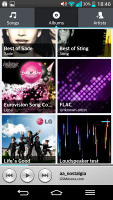
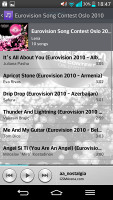
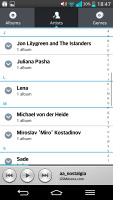
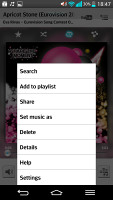
The Now playing interface places a big album art image in
the center with controls above and below it. Swiping the album art left or
right is the easiest way to skip songs back and forth.
A press and hold on the album art will bring up a search
menu, if you need to look up the title, artist or the album. After that you can
pick where to search - your music collection, YouTube or a general Internet
search. Flipping the device to landscape mode while on the Now playing screen
squeezes in a list of other songs by the same artist.

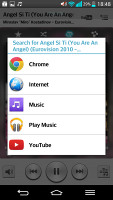
I've been using the G2 as my daily
since getting it, and have been really quite impressed with the device. LG's
battery size is large, and the battery life tests back up the subjectively long
longevity that I've noticed. Obviously the process improvements from 28nm HPM
and power saving features in the G2 like GRAM/PSR make an improvement
here. It seems like with Snapdragon 800 we may be ushering in a new
generation of battery performance, despite the lack of a traditional process
node shrink. It just goes to show you that there can be benefits other than
more performance from using a high-end phone. The G2 is the first device
we've seen with 28nm HPM silicon inside, which Qualcomm will be on for
while.
There are, of course, performance
benefits to talk about as well. Qualcomm's Snapdragon 800 (MSM8974), delivers
solid improvements relative to Snapdragon 600 (APQ8064T). Although in some
tests the G2's performance isn't quite near the MDP/T we tested a while back,
that's due in part to the thermal constraints of being in a phone and also the
still not quite final software on the G2 that LG wanted to get to us quickly.
LG took a bold risk by putting the
volume and power buttons on the back of the G2, something I initially suspected
would be awkward and cumbersome. However it actually makes a lot of sense and
allows the G2 to further decrease the edge bezel thickness and prevent the
device from getting too wide, which is what I find affects in-hand fatigue
quite a lot. After a day or so the back buttons are basically second nature, and
I've been using the volume down to launch camera shortcut quite a bit. I'd take
a back mounted power button over a top mounted power button anytime after using
the G2.
The G2's large display doesn't really
add to the overall dimensions of the device, thanks to its unique design
decisions. The panel also seems to come reasonably well calibrated out of the
box, generally equaling the color accuracy we've seen from the iPhone 5 and HTC
One. I can't help but be happy that we're finally seeing color accuracy taken
seriously by some Android vendors.
On the camera side, having another Android phone with OIS is an awesome
bonus. I love that we're getting more devices now with OIS and better emphasis
on camera, and the results out of the G2 with the combination of that feature
and 13 MP CMOS look very impressive in all but challenging low light
situations. There's definitely OIS performance differences between the players
that have it now, and room for further tuning and improvement, but it's already
a huge help especially in handheld video. Likewise, finally having
1080p60 on a flagship device is absolutely awesome, now if
only YouTube and other sharing mediums would follow suit with 60 FPS support.
Overall LG's G2 is surprisingly good.
It's built on a great platform, with great battery life and includes a number
of design decisions that show honest to goodness innovative thinking on LG's
part. We'll wait to give our final recommendation on the G2 until we get an LTE
version with final software, but if you're looking for an Android phone with a
~5" display this fall the G2 looks like it could be high on your list.




